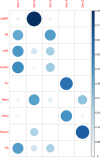The food patterns of a multicenter cohort of Brazilian nulliparous pregnant women
- PMID: 34330978
- PMCID: PMC8324872
- DOI: 10.1038/s41598-021-95185-2
The food patterns of a multicenter cohort of Brazilian nulliparous pregnant women
Abstract
Assessment of human nutrition is a complex process, in pregnant women identify dietary patterns through mean nutrient consumption can be an opportunity to better educate women on how to improve their overall health through better eating. This exploratory study aimed to identify a posteriori dietary patterns in a cohort of nulliparous pregnant women. The principal component analysis (PCA) technique was performed, with Varimax orthogonal rotation of data extracted from the 24-h dietary recall, applied at 20 weeks of gestation. We analysed 1.145 dietary recalls, identifying five main components that explained 81% of the dietary pattern of the sample. Dietary patterns found were: Obesogenic, represented by ultra-processed foods, processed foods, and food groups rich in carbohydrates, fats and sugars; Traditional, most influenced by natural, minimally processed foods, groups of animal proteins and beans; Intermediate was similar to the obesogenic, although there were lower loads; Vegetarian, which was the only good representation of fruits, vegetables and dairy products; and Protein, which best represented the groups of proteins (animal and vegetable). The obesogenic and intermediate patterns represented over 37% of the variation in food consumption highlighting the opportunity to improve maternal health especially for women at first mothering.
© 2021. The Author(s).
Conflict of interest statement
The authors declare no competing interests.
Figures



References
-
- Institute of Medicine and National Research Council Weight gain during pregnancy: Reexamining the guidelines. Wash. Natl. Acad. Press. Natl. Acad. Sci. 2009;1:2. - PubMed
Publication types
MeSH terms
LinkOut - more resources
Full Text Sources

